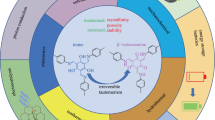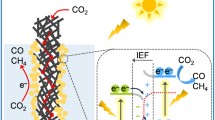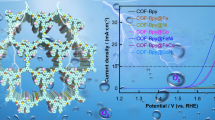Abstract
Cycloaddition reaction using CO2 as a starting material to form a cyclic carbonate has been applied to chemical fixation of CO2. In order to further increase the reaction efficiency, herein, a bifunctional catalyst (CPBrs) containing metalloporphyrin and quaternary phosphonium salt groups was prepared, and the related catalytic performance for CO2 conversion was also studied. The catalytic system possesses multiple active sites of zinc porphyrin (Lewis acids) and quaternary phosphonium bromide salts (nucleophilic reagents), which can cooperatively work together to enhance the efficiency of cycloaddition reaction. At the same time, CPBrs (CPBr-1 and CPBr-2) are microporous polymers with permanent microporous pore structure and high specific surface areas (342–370 m2 g−1). Their moderate capacities (5.76 and 8.81% at 1 bar/273 K) to capture carbon dioxide were also beneficial for CO2 conversion. The activity of the bifunctional catalyst is higher than that of the catalyst with a single component. The corresponding highest yield to catalyze cycloaddition reaction between methyl substituented propylene oxide and CO2 is up to 95% (2.5 MPa, 90 °C). What is more, the porous nature of catalysts provides the recoverability of the catalyst, and the efficiency of the catalyst CPBr-2 remains high (above 90% yield) after five catalytic recycle.
Graphic abstract






Similar content being viewed by others
References
Yan D, Liu J, Fu X, Liu P, Luo H (2019) Low-temperature synthesis of mesoporous boron carbides as metal-free photocatalysts for enhanced CO2 reduction and generation of hydroxyl radicals. J Mater Sci 54:6151–6163. https://doi.org/10.1007/s10853-018-03284-9
Kim H, Moon HS, Sohail M, Yoon Y, Shah S, Yim K, Moon J, Park Y (2019) Synthesis of cyclic carbonate by CO2 fixation to epoxides using interpenetrated MOF-5/n-Bu4NBr. J Mater Sci 54:11796–11803. https://doi.org/10.1007/s10853-019-03702-6
Guo L, Cao J, Zhang J, Hao Y, Bi K (2019) Photoelectrochemical CO2 reduction by Cu2O/Cu2S hybrid catalyst immobilized in TiO2 nanocavity arrays. J Mater Sci 54:10379–10388. https://doi.org/10.1007/s10853-019-03615-4
Murugesan P, Narayanan S, Matheswaran M (2019) Visible light photocatalytic conversion of CO2 in aqueous solution using 2D-structured carbon-based catalyst-coated β, γ-AgI nanocomposite. J Mater Sci 54:7798–7810. https://doi.org/10.1007/s10853-019-03389-9
Ren M, Zhang T, Wang Y, Jia Z, Cai J (2019) A highly pyridinic N-doped carbon from macroalgae with multifunctional use toward CO2 capture and electrochemical applications. J Mater Sci 54:1606–1615. https://doi.org/10.1007/s10853-018-2927-7
Wu K, Dong X, Zhu J, Wu P, Liu C, Wang Y, Wu J, Hou J, Liu Z, Guo X (2018) Designing biomimetic porous celery: TiO2/ZnO nanocomposite for enhanced CO2 photoreduction. J Mater Sci 53:11595–11606. https://doi.org/10.1007/s10853-018-2397-y
Lu Z, Du L, Zhen B, Bai J, Zhang M, Yun R (2013) A highly porous agw-type metal-organic framework and its CO2 and H2 adsorption capacity. CrystEngComm 15:9348–9351. https://doi.org/10.1039/c3ce41119b
Wang Z, Zheng B, Liu H, Yi P, Li X, Yu X, Yun R (2013) A highly porous 4,4-paddlewheel-connected NbO-type metal-organic framework with a large gas-uptake capacity. Dalt Trans 42:11304–11311. https://doi.org/10.1039/c3dt50704a
Yun R, Cu R, Qian F, Cao X, Luo S, Zheng B (2015) Formation of a metal-organic framework with high gas uptakes based upon amino-decorated polyhedral cages. RSC Adv 5:2374–2377. https://doi.org/10.1039/c4ra14607g
Zheng B, Huang L, Cao X, She S, Cao H, Hang C, Zeng W, Wang Z, (2018) A highly porous acylamide decorated MOF-505 analogue exhibiting large and selective CO2 gas uptake capability. CrystEngComm 20:1874–1881. https://doi.org/10.1039/c8ce00103k
Zheng B, Wang H, Wang Z, Ozaki N, Hang C, Luo X, Huang L, Zeng W, Yang M, Duan J (2016) A highly porous rht-type acylamide-functionalized metal-organic framework exhibiting large CO2 uptake capabilities. Chem Commun 52:12988–21299. https://doi.org/10.1039/c6cc06734d
Zheng B, Luo X, Wang Z, Zhang S, Yun R, Huang L, Zeng W, Liu W (2018) An unprecedented water stable acylamide-functionalized metal-organic framework for highly efficient CH4/CO2 gas storage/separation and acid-base cooperative catalytic activity. Inorg Chem Front 5:2355–2363. https://doi.org/10.1039/c8qi00662h
Abousalman-Rezvani Z, Eskandari P, Roghani-Mamaqani H, Mardani H, Salami-Kalajahi M (2019) Grafting light-, temperature, and CO2-responsive copolymers from cellulose nanocrystals by atom transfer radical polymerization for adsorption of nitrate ions. Polymer 182:121830. https://doi.org/10.1016/j.polymer.2019.121830
Shi K, Song N, Zou Y, Zhu S, Tan H, Tian Y, Zhang B, Yao H, Guan S (2019) Porphyrin-based porous polyimides: Synthesis, porous structure, carbon dioxide adsorption. Polymer 169:160–166. https://doi.org/10.1016/j.polymer.2019.02.062
Maeda C, Sasaki S, Ema T (2017) Electronic tuning of zinc porphyrin catalysts for the conversion of epoxides and carbon dioxide into cyclic carbonates. ChemCatChem 9:946–949. https://doi.org/10.1002/cctc.201601690
Dyduch K, Srebro-Hooper M, Lee B, Michalak A (2018) Exploring the conformational space of cobalt(III)–salen catalyst for CO2/epoxide copolymerization: effect of quaternary ammonium salts on preference of alternative isomers. J Comput Chem 39:1854–1867. https://doi.org/10.1002/jcc.25358
Biswas S, Khatun R, Sengupta M, Islam S (2018) Polystyrene supported zinc complex as an efficient catalyst for cyclic carbonate formation via CO2 fixation under atmospheric pressure and organic carbamates production. Mol Catal 452:129–137. https://doi.org/10.1016/j.mcat.2018.04.009
Aresta M, Dibenedetto A, Angelini A (2014) Catalysis for the valorization of exhaust carbon: From CO2 to chemicals, materials, and fuels. technological use of CO2. Chem Rev 114:1709–1742. https://doi.org/10.1021/cr4002758
Cokoja M, Wilhelm M, Anthofer M, Herrmann W, Kühn F (2015) Synthesis of cyclic carbonates from epoxides and carbon dioxide by using organocatalysts. Chemsuschem 8:2436–2454. https://doi.org/10.1002/cssc.201500161
Jayakumar S, Li H, Zhao Y, Chen J, Yang Q (2017) Cocatalyst-free hybrid ionic liquid (IL)-based porous materials for efficient synthesis of cyclic carbonates through a cooperative activation pathway. Chem An Asian J 12:577–585. https://doi.org/10.1002/asia.201601676
Peng J, Wang S, Yang H, Ban B, Wei Z, Wang L, Lei B (2018) Highly efficient fixation of carbon dioxide to cyclic carbonates with new multi-hydroxyl bis-(quaternary ammonium) ionic liquids as metal-free catalysts under mild conditions. Fuel 224:481–488. https://doi.org/10.1016/j.fuel.2018.03.119
Lan D, Gong Y, Tan N, Wu S, Shen J, Yao K, Yi B, Au C, Yin S (2018) Multi-functionalization of GO with multi-cationic ILs as high efficient metal-free catalyst for CO2 cycloaddition under mild conditions. Carbon N Y 127:245–254. https://doi.org/10.1016/j.Carbon.2017.11.007
Martínez J, Castro-Osma J, Earlam A, Alonso-Moreno C, Otero A, Lara-Sánchez A, North M, Rodríguez-Diéguez A (2015) Synthesis of cyclic carbonates catalysed by aluminium heteroscorpionate complexes. Chem A Eur J 21:9850–9862. https://doi.org/10.1002/chem.201500790
An Q, Li Z, Graff R, Guo J, Gao H, Wang C (2015) Core-double-shell Fe3O4 @Carbon@Poly(InIII -carboxylate) microspheres: cycloaddition of CO2 and epoxides on coordination polymer shells constituted by imidazolium-derived AlIII-salen bifunctional catalysts. ACS Appl Mater Interfaces 7:4969–4978. https://doi.org/10.1021/acsami.5b00066
Maya E, Rangel-Rangel E, Díaz U, Iglesias M (2018) Efficient cycloaddition of CO2 to epoxides using novel heterogeneous organocatalysts based on tetramethylguanidine-functionalized porous polyphenylenes. J. CO2 Util. 25: 170–179. doi:10.1016/j.jcou.2018.04.001.
Pan Y, Zhai X, Yin J, Zhang T, Ma L, Zhou Y, Zhang Y, Meng J (2019) Hierarchical porous and Zinc-Ion-Crosslinked PIM-1 nanocomposite as a CO2 cycloaddition catalyst with high efficiency. Chemsuschem 12:2231–2239. https://doi.org/10.1002/cssc.201803066
Leng Y, Lu D, Zhang C, Jiang P, Zhang W, Wang J (2016) Ionic polymer microspheres bearing a CoIII-Salen moiety as a bifunctional heterogeneous catalyst for the efficient cycloaddition of CO2 and epoxides. Chem Eur J 22:8368–8375. https://doi.org/10.1002/chem.201600755
Liu D, Li G, Liu J, Yi Y (2019) Organic-inorganic hybrid mesoporous titanium silica material as bi-functional heterogeneous catalyst for the CO2 cycloaddition. Fuel 244:196–206. https://doi.org/10.1016/j.fuel.2019.01.167
Zhang S, Shi W, Cheng P (2017) The coordination chemistry of N-heterocyclic carboxylic acid: a comparison of the coordination polymers constructed by 4,5-imidazoledicarboxylic acid and 1H–1,2,3-triazole-4,5-dicarboxylic acid. Coord Chem Rev 352:108–150. https://doi.org/10.1016/j.ccr.2017.08.022
Liu Q, Tang Z, Wu M, Zhou Z (2014) Design, preparation and application of conjugated microporous polymers. Polym Int 63:381–392. https://doi.org/10.1002/pi.4640
Liu Q, Wu M, Duan Y, Ou B, Liao B, Shen S, Zhou H (2015) Functional Block Copolymers from Controlled Radical and Ring Opening Polymerization. Polym Sci B 57:387–394. https://doi.org/10.1134/s1560090415050097
Liu Q, Tang Z, Wu M, Liao B, Zhou H, Ou B, Yu G, Zhou Z, Li X (2015) Novel ferrocene-based nanoporous organic polymers for clean energy application. RSC Adv 5:8933–8977. https://doi.org/10.1039/c4ra12834f
Li G, Liu Q, Xia B, Huang J, Li S, Guang Y, Zhou H, Liao B, Zhou Z, Liu B (2017) Synthesis of stable metal-containing porous organic polymers for gas storage. Eur Polym J 91:242–247. https://doi.org/10.1016/j.eurpolymj.2017.03.014
Li G, Liu Q, Liao B, Chen L, Zhou H, Zhou Z, Xia B, Huang J, Liu B (2017) Synthesis of novel ferrocene-based conjugated microporous polymers with intrinsic magnetism. Eur Polym J 93:556–560. https://doi.org/10.1016/j.eurpolymj.2017.06.034
Feng L, Zhang S, Sun X, Dong A, Chen Q (2018) Boronic acid-Functionalized porous polycarbazoles: preparation, adsorption performance, and heterogeneous catalysts for selective oxidation. J Mater Sci 53:15025–15033. https://doi.org/10.1007/s10853-018-2682-9
Chen Q, Han B (2018) Microporous polycarbazole materials : from preparation and properties to applications. Macromol Rapid Commun 39:1–11. https://doi.org/10.1002/marc.201800040
Liang H, Chen Q, Han B (2018) Cationic polycarbazole networks as visible-light heterogeneous photocatalysts for oxidative organic transformations. ACS Catal 8:5313–5322. https://doi.org/10.1021/acscatal.7b04494
Chen Q, Dong A, Wang D, Qiu L, Ma C, Yuan Y, Zhao Y, Jia N, Guo Z, Wang N (2019) Direct methane conversion efficient and selective methane borylation through pore size tuning of hybrid porous organic-polymer-based Iridium catalysts. Angew Chem Int Ed 131:10671–10676. https://doi.org/10.1002/anie.201906350
Chen Q, Yin Q, Dong A, Gao Y, Qian Y, Wang D, Dong M, Shao Q, Liu H, Han B, Ding T, Guo Z, Wang N (2019) Metal complex hybrid composites based on fullerene-bearing porous polycarbazole for H2, CO2 and CH4 uptake and heterogeneous hydrogenation catalysis. Polymer 169:255–262. https://doi.org/10.1016/j.polymer.2019.02.056
Feng L, Chen Q, Zhu J, Liu D, Zhao Y, Han B (2014) Adsorption performance and catalytic activity of porous conjugated polyporphyrins via carbazole-based oxidative coupling polymerization. Polym Chem 5:3081–3088. https://doi.org/10.1039/c3py01430d
Maeda C, Taniguchi T, Ogawa K, Ema T (2015) Bifunctional catalysts based on m-phenylene-bridged porphyrin dimer and trimer platforms: synthesis of cyclic carbonates from carbon dioxide and epoxides. Angew Chem Int Ed 54:134–138. https://doi.org/10.1002/anie.201409729
Chen Q, Liu D, Zhu J, Han B (2014) Mesoporous conjugated polycarbazole with high porosity via structure tuning. Macromolecules 47:5926–5931. https://doi.org/10.1021/ma501330v
Qiu J, Zhao Y, Li Z, Wang H, Shi Y, Wang J (2019) Imidazolium-salt-functionalized covalent organic frameworks for highly efficient catalysis of CO2 conversion. Chemsuschem 12:2421–2427. https://doi.org/10.1002/cssc.201900570
Chen Q, Luo M, Hammershøj P, Han Y, Laursen B, Yan C, Han B (2012) Microporous Polycarbazole with High Specific Surface Area for Gas Storage and Separation. J Am Chem Soc 134:6084–6087. https://doi.org/10.1021/ja300438w
Liu B, Li X, Maciołek J, Stȩpień M, Chmielewski P (2014) Regioselective internal carbonylation of the 2-Aza-21-carbaporphyrin: access to configurationally stable chiral porphyrinoids. J Org Chem 79:3129–3139. https://doi.org/10.1021/jo500272t
Deng K, Zhou J, Li X (2013) Electrochimica Acta Noncovalent nanohybrid of cobalt tetraphenylporphyrin with graphene for simultaneous detection of ascorbic acid, dopamine, and uric acid. Electrochim Acta 114:341–346. https://doi.org/10.1016/j.electacta.2013.09.164
Zhang S, Li H, Duan E, Han Z, Li L, Tang J, Shi W, Cheng P (2016) A 3D heterometallic coordination polymer constructed by trimeric NiDy2 single-molecule magnet units. Inorg Chem 55:1202–1207. https://doi.org/10.1021/acs.inorgchem.5b02378
Ema T, Miyazaki Y, Shimonishi J, Maeda C, Hasegawa J (2014) Bifunctional porphyrin catalysts for the synthesis of cyclic carbonates from epoxides and CO2: structural optimization and mechanistic study. J Am Chem Soc 136:15270–15279. https://doi.org/10.1021/ja507665a
Jayakumar S, Li H, Tao L, Li C, Liu L, Chen J, Yang Q (2018) Cationic Zn-porphyrin immobilized in mesoporous silicas as bifunctional catalyst for CO2 cycloaddition reaction under cocatalyst free conditions. ACS Sustain Chem Eng 6:9237–9245. https://doi.org/10.1021/acssuschemeng.8b01548
Jayakumar S, Li H, Chen J, Yang Q (2017) Cationic Zn-porphyrin polymer coated onto CNTs as cooperative catalyst for synthesis of cyclic carbonates. ACS Appl Mater Interfaces 10:2546–2555. https://doi.org/10.1021/acsami.7b16045
Chen J, Zhong M, Tao L, Liu L, Jayakumar S, Li C, Li H, Yang Q (2018) The cooperation of porphyrin-based porous polymer and thermal-responsive ionic liquid for efficient CO2 cycloaddition reaction. Green Chem 20:903–911. https://doi.org/10.1039/c7gc03801a
Xu H, Chen X, Gao J, Lin J, Addicoat M, Irle S, Jiang D (2014) Catalytic covalent organic frameworks via pore surface engineering. Chem Commun 50:1292–1294. https://doi.org/10.1039/c3cc48813f
Chen Y, Luo R, Xu Q, Jiang J, Zhou X, Ji H (2017) Charged metalloporphyrin polymers for cooperative synthesis of cyclic carbonates from CO2 under ambient conditions. Chemsuschem 10:2534–2541. https://doi.org/10.1002/cssc.201700536
Wang W, Li C, Yan L, Wang Y, Jiang M, Ding Y (2016) Ionic liquid/Zn-PPh3 integrated porous organic polymers featuring multifunctional sites: highly active heterogeneous catalyst for cooperative conversion of CO2 to cyclic carbonates. ACS Catal 6:6091–6100. https://doi.org/10.1021/acscatal.6b01142
DaiZ SQ, Liu X, Bian C, Wu Q, Pan S, Wang L, Meng X, Deng F, Xiao F (2016) Metalated porous porphyrin polymers as efficient heterogeneous catalysts for cycloaddition of epoxides with CO2 under ambient conditions. J Catal 338:202–209. https://doi.org/10.1016/j.jcat.2016.03.005
Chen Y, Luo R, Xu Q, Jiang J, Zhou X, Ji H (2018) Metalloporphyrin polymers with intercalated ionic liquids for synergistic CO2 fixation via cyclic carbonate production. ACS Sustain Chem Eng 6:1074–1082. https://doi.org/10.1021/acssuschemeng.7b03371
Xiong S, Tang X, Pan C, Li L, Tang J, Yu G (2019) Carbazole-bearing porous organic polymers with a mulberry-like morphology for efficient iodine capture, ACS Appl. Mater Interfaces 11:27335–27342. https://doi.org/10.1021/acsami.9b07679
Hung T, Thang N, Hoang D, Dang T, Villinger A, Langer P (2014) Efficient synthesis of biscarbazoles by palladium-catalyzed twofold C-N coupling and C-H activation reactions. Org Biomol Chem 12:2596–2605. https://doi.org/10.1039/c3ob41746h
Li C, Wang W, Yan L, Wang Y, Jiang M, Ding Y (2016) Phosphonium salt and ZnX2 -PPh3 integrated hierarchical POPs: Tailorable synthesis and highly efficient cooperative catalysis in CO2 utilization. J Mater Chem A 4:16017–16027. https://doi.org/10.1039/c6ta05823j
Elhaj E, Wang H, Gu Y (2019) Functionalized quaternary ammonium salt ionic liquids (FQAILs) as an economic and salt ionic liquids (FQAILs) as an economic and efficient catalyst for synthesis of glycerol carbonate from glycerol and dimethyl carbonate. Mol Catal 46:19–28. https://doi.org/10.1016/j.mcat.2019.02.005
Yarie M, Zolfigol M, Baghery S, Alonso D, Khoshnood A, Bayat Y, Asgari A (2018) Triphenyl(3-sulfopropyl)phosphonium trinitromethanide as a novel nanosized molten salt: catalytic activity at the preparation of dihydropyrano[2,3-c]pyrazoles. J Mol Liq 271:872–884. https://doi.org/10.1016/j.molliq.2018.09.054
Martín C, Fiorani G, Kleij A (2015) Recent advances in the catalytic preparation of cyclic organic carbonates. ACS Catal 5:1353–1370. https://doi.org/10.1021/cs5018997
Ema T, Miyazaki Y, Koyama S, Yano Y, Sakai T (2012) A bifunctional catalyst for carbon dioxide fixation: Cooperative double activation of epoxides for the synthesis of cyclic carbonates. Chem Commun 48:4489–4491. https://doi.org/10.1039/c2cc30591g
Acknowledgements
Qi Chen and Zhuyin Sui are grateful to the selfless support from Prof. Dr. Bao-Hang Han in the National Center for Nanoscience and Technology, China. The financial support of the Key Research and Development Program of Hainan Province (ZDYF2019016), the National Natural Science Foundation of China (51873053 and 21975058), and the Science and Technology Project of Guizhou Province (Grant QKH Platform talents [2017]5733–067) is acknowledged. Zhuyin Sui also acknowledges the Taishan Scholars Program (Grant No. tsqn201909087).
Author information
Authors and Affiliations
Corresponding authors
Ethics declarations
Conflict of interest
The work described has not been published previously, that it is not under consideration for publication elsewhere, that its publication is approved by all authors and tacitly or explicitly by the responsible authorities where the work was carried out, and that, if accepted, it will not be published elsewhere in the same form, in English or in any other language, without the written consent of the copyright holder. All authors have seen the manuscript and approved to submit to your journal. The authors declare no competing financial interest.
Additional information
Publisher's Note
Springer Nature remains neutral with regard to jurisdictional claims in published maps and institutional affiliations.
Electronic supplementary material
Below is the link to the electronic supplementary material.
Rights and permissions
About this article
Cite this article
Lu, Y., Chang, Z., Zhang, S. et al. Porous organic polymers containing zinc porphyrin and phosphonium bromide as bifunctional catalysts for conversion of carbon dioxide. J Mater Sci 55, 11856–11869 (2020). https://doi.org/10.1007/s10853-020-04851-9
Received:
Accepted:
Published:
Issue Date:
DOI: https://doi.org/10.1007/s10853-020-04851-9




